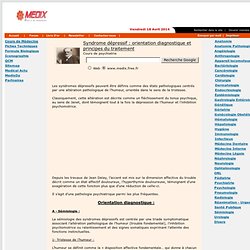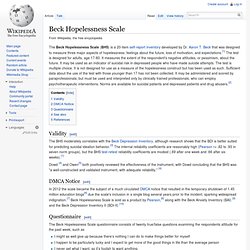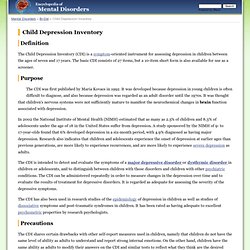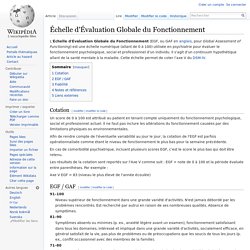

Www.libantestseditions.com/pdf/PersonaliteFinale.pdf.
Opac.invs.sante.fr/doc_num.php?explnum_id=3017. Expérience temporelle du plaisir. Image de soi. Concept du soi. Syndrome dépressif : orientation diagnostique et principes du traitement. Les syndromes dépressifs peuvent être définis comme des états pathologiques centrés par une altération pathologique de l’humeur, orientée dans le sens de la tristesse.

Classiquement, cette altération est décrite comme un fléchissement du tonus psychique, au sens de Janet, dont témoignent tout à la fois la dépression de l’humeur et l’inhibition psychomotrice. Depuis les travaux de Jean Delay, l’accent est mis sur la dimension affective du trouble décrit comme un état affectif douloureux, l’hyperthymie douloureuse, témoignant d’une exagération de cette fonction plus que d’une réduction de celle-ci. Il s’agit d’une pathologie psychiatrique parmi les plus fréquentes. Orientation diagnostique : What We Do > SF Health Surveys > SF-36v2 Health Survey > QualityMetric Incorporated. QualityMetric's SF-36v2® Health Survey asks 36 questions to measure functional health and well-being from the patient's point of view.

It is a practical, reliable, and valid measure of physical and mental health that can be completed in five to ten minutes. It’s called a generic health survey because it can be used across age (18 and older), disease, and treatment group, as opposed to a disease-specific health survey which focuses on a particular condition or disease. The survey is meaningful to patients, clinicians, researchers, and administrators across the health care spectrum, and has various applications. These include: SF-12® Health Survey Scoring Demonstration.
PubMed Central, Figure 1: Trials. 2010; 11: 105. Published online 2010 November 12. doi: 10.1186/1745-6215-11-105. Beck Hopelessness Scale. The Beck Hopelessness Scale (BHS) is a 20-item self-report inventory developed by Dr.

Aaron T. Beck that was designed to measure three major aspects of hopelessness: feelings about the future, loss of motivation, and expectations.[1] The test is designed for adults, age 17-80. It measures the extent of the respondent's negative attitudes, or pessimism, about the future. It may be used as an indicator of suicidal risk in depressed people who have made suicide attempts. The test is multiple choice. Validity[edit] The BHS moderately correlates with the Beck Depression Inventory, although research shows that the BDI is better suited for predicting suicidal ideation behavior.[3] The internal reliability coefficients are reasonably high (Pearson r= .82 to .93 in seven norm groups), but the BHS test-retest reliability coefficients are modest (.69 after one week and .66 after six weeks).[1] DMCA Notice[edit] Questionnaire[edit] See also[edit] References[edit]
HDRS = HAMILTON DEPRESSION SCALE (hétéro evaluation)
Decision Making Individual Differences Inventory - home. Note that our URL has changed.

Please change bookmarks and links. To add a measure, try this form and see this sample for what it may look like in the end. To modify a measure already here, write webmaster@sjdm.org. Eventually we will set up a better system. The DMIDI was developed by Kirstin Appelt with Kerry Milch, Michel Handgraaf, & Elke Weber. The DMIDI is a catalogue of over 170 individual difference measures commonly used in judgment and decision-making research. Www.webpages.ttu.edu/areifman/qic.htm. Prise en charge la dépression par l'assurance maladie. Www.iprps.be/pdf/ES3TD.pdf. Www.iprps.be/pdf/deLeval.pdf. Questionnaires Psychologiques Pour L'activité Physique, le Sport et L ... - Nathalie André, Louis Laurencelle. Test SEI INVENTAIRE D'ESTIME DE SOI DE COOPERSMITH FORME ADULTE - Ressources humaines.
Evaluation de l'estime de soi. Evaluation par echelle de dépression (BDI-II ; Beck, Steer, & Brown, 1996)
Childs. Web.udl.cat/usuaris/e7806312/publi/pu_35.pdf. Child Depression Inventory - children, therapy, adults, people, used, brain, personality, score, skills. Photo by: Mikael Damkier Definition The Child Depression Inventory (CDI) is a symptom-oriented instrument for assessing depression in children between the ages of seven and 17 years.

The basic CDI consists of 27 items, but a 10-item short form is also available for use as a screener. Purpose The CDI was first published by Maria Kovacs in 1992. In 2002 the National Institute of Mental Health (NIMH) estimated that as many as 2.5% of children and 8.3% of adolescents under the age of 18 in the United States suffer from depression.
The CDI is intended to detect and evaluate the symptoms of a major depressive disorder or dysthymic disorder in children or adolescents, and to distinguish between children with those disorders and children with other psychiatric conditions. The CDI has also been used in research studies of the epidemiology of depression in children as well as studies of dissociative symptoms and post-traumatic syndromes in children. Precautions Description Results Resources. Refdoc. Docs.bossons-fute.fr/Documents/Risques psychosociaux/Echelle CES-D.pdf. Stop-tabac.ch: Questionnaire CES-D sur la dépression. Center on Early Adolescence: Measures. Echelle-had. (HDRS) Journal of Affective Disorders - A very short visual analog form of the Center for Epidemiologic Studies Depression Scale (CES-D) for the idiographic measurement of depression.
Received 7 April 2010; received in revised form 2 June 2010; accepted 3 June 2010.

Background The experience sampling method, also referred to as ecological momentary assessment (ESM-EMA) has recently gained popularity in the study of depression. However, no psychometrically sound multidimensional depression questionnaires specifically designed for the ESM-EMA context are currently available. Aims The main objective of the present study was to develop and validate a very short visual analog scale of the Center for Epidemiologic Studies Depression Scales (CES-D-VAS-VS) specifically designed for the ESM-EMA context. Study design A sample comprising 163 patients with a major depressive episode (MDE) and 306 participants without mental disorders was involved in this study. Journal of Affective Disorders - A very short visual analog form of the Center for Epidemiologic Studies Depression Scale (CES- D) for the idiographic measurement of depression.
Échelle d'Évaluation Globale du Fonctionnement. Un article de Wikipédia, l'encyclopédie libre.

L’Échelle d'Évaluation Globale du Fonctionnement (EGF, ou GAF en anglais, pour Global Assessment of Functioning) est une échelle numérique (allant de 0 à 100) utilisée en psychiatrie pour évaluer le fonctionnement psychologique, social et professionnel d’un individu.